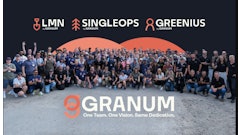
For years landscape companies have focused on a couple of primary growth strategies: branch into new markets at the request of one or two key clients, or buy other landscape companies. The problem is that neither of these tactics addresses the one thing that truly drives vigorous growth in companies: innovation.
As of late, many landscape companies have been focusing on operational efficiency as a means to outperform the competition. The problem here is that operational efficiency doesn't really lead to innovation, either. Yes, it leads to reduced costs, so it is definitely a necessity in today's world of landscape contracting. But if you want to grow sales in today's market, you as the owner, along with your key people, have to focus on innovation.
Innovation starts with strategic positioning
According to Tom Oyler, one of the most successful entrepreneurs the Green Industry has seen, when you're talking about innovation, you're really talking about strategic positioning. It's not necessarily a revolutionary new product or service. You simply want to do the things everyone does—but you want to do them differently. Or, you want to do altogether different things than your competitors do.
Innovation is understanding your customers
Oyler thinks back to when he was a contractor. After being in business a few years, he obtained his realtor's license. "I figured that the real estate industry was the landscape industry's ‘driver,’ and wanted to better understand the real estate business and its terminology," Oyler relates. "That way, clients would view me as more of a peer, and not just a vendor. To sell a developer you have to think like a developer."
Matthew Johnson of Asset Landscaping in Phoenix, AZ, is a present-day landscape contractor who also has a realtor's license. "One benefit is that I have additional training on the importance and value of real estate, along with what features affect real estate values the most," Johnson says. "Another benefit is for commercial and homeowner association business. I know the laws pertaining to how the properties must operate. The Arizona License requires hours of instruction on HOA law, along with continuing education classes that are required to review new laws."
It's unrealistic to think that every landscape contractor is going to run out and get his realtor's license this fall. But it does make sense that innovation-minded contractors will take steps to learn more about the real estate business, such as by visiting websites like www.realtor.org.
There are other avenues for contractors to expand their knowledge base and learn more about their customers. Consider attending conferences geared toward developers, homebuilders or facilities managers. Learn as much as you can about green building and LEED. Contractors such as John Reffel of JLS Landscape & Sprinkler in Sedalia, CO, have even earned LEED accreditation.
Innovation is your personal touch
It's definitely important to know your customers inside and out. Finding innovative ways to make some of their pains go away can be game-changing.
Greenscapes of Southwest Florida has come up with an innovation that has resulted in increased customer retention and market share. Co-owner Linda Nelson says today's consumers expect a lot more personal attention. So Greenscapes has created Client Services Teams in order to increase the number of client interactions each month. This approach also puts more eyes on a property, resulting in improved quality control and more upsell opportunities.
Oyler recalls an innovation he came up with years ago while bidding on an outdoor retail center. "I told the property manager that we would put an English-speaking crewmember on their property every day to not only police the grounds, but also to act like a concierge in the parking lot, helping change tires or jumpstart batteries," Oyler says.
In another instance, Oyler went to visit a prospective client and walk the property. "I found out that the manager spent a few hours every Friday doing a property inspection," Oyler tells. "I won that job because I said we could give her a virtual inspection through a systematic approach to updates and communication. I also gave her advice on how we could greatly simplify the landscape."
Innovation is a new product
As you can see, innovation is often a matter of finding a unique way to provide value to the client. But sometimes, providing this value does translate into the need for a new product.
A good example of this is one of Oyler’s present-day companies, New South Equipment Mats. The company provides temporary road systems using eco-friendly, heavy-duty mats to help equipment get into challenging environments. But the company identified a strategic position of providing “total access solutions” for heavy equipment in challenging environments.
“Just that mindset shift forced everyone in our organization to start thinking about what ‘total access solution’ really means," Oyler explains. "That means we have to be able to get anywhere, anytime, anyhow … no matter what. And we have to do it in an eco-friendly way. In order to achieve that, we had to create a way to get into wetlands, for example.” This strategic positioning led New South Equipment Mats to develop a new roadway and bridging system called EarthSafe. New South’s sales have grown at a compounded annual growth rate of 1,200% since the company was founded in 2007, landing them in Inc. Magazine’s fastest 500 as the 270th fastest-growing private company in the U.S.
California landscaper Tom De Lany is another example. He wanted to help customers conserve water. He came up with a polymer-injecting machine called Aqua Cents that helps reduce outdoor water usage by well over 50%.
The point is that, in both of these cases, the new product innovation was derived from an initial strategic positioning based on providing an advantage to consumers.
Innovation is a service advantage
Back down in Naples, FL, Nelson of Greenscapes has her eye on a potential new service opportunity. The company specializes in commercial landscape maintenance. Nelson would now like to start bidding on municipal, state and utility work.
"This is work we could do on the weekends," Nelson points out. That's a bonus, because existing machinery is setting idle Friday through Sunday, since Greenscapes runs four 10-hour days. "Even if I have to bid this work a little bit lower than I'd like, it's still surplus money."
In Arkansas, Terry Delany of GroundSERV has worked to create a strategic position of "complete exterior maintenance service provider." Delany says, "If it’s outside the sheetrock and inside the property lines, we can handle it.” Landscape maintenance is still GroundSERV's biggest service segment. However, the company also offers parking lot sealing and striping, parking lot sweeping, window washing, emergency storm response, irrigation repair and service, pressure washing, brush-hogging, snow and ice management, and tree care.
In some markets, this type of approach might not work. It all depends on what is happening in your given area—and what your competitors are or are not doing.
"For companies to grow in a service industry, you have to break away from imitation and pursuit," Oyler advises. "Get out and talk with your clients. Learn about their businesses, their challenges, and how you can help them." Only then will you identify how to serve them in an innovative way.


![Doosan Bobcat Wacker Neuson Stack 2ec Js Pb V6e[1]](https://img.greenindustrypros.com/mindful/acbm/workspaces/default/uploads/2025/12/doosan-bobcat-wacker-neuson-stack2ecjspbv6e1.CPyyz8ubHn.png?auto=format%2Ccompress&bg=fff&fill-color=fff&fit=fill&h=100&q=70&w=100)








![Doosan Bobcat Wacker Neuson Stack 2ec Js Pb V6e[1]](https://img.greenindustrypros.com/mindful/acbm/workspaces/default/uploads/2025/12/doosan-bobcat-wacker-neuson-stack2ecjspbv6e1.CPyyz8ubHn.png?ar=16%3A9&auto=format%2Ccompress&bg=fff&fill-color=fff&fit=fill&h=135&q=70&w=240)








